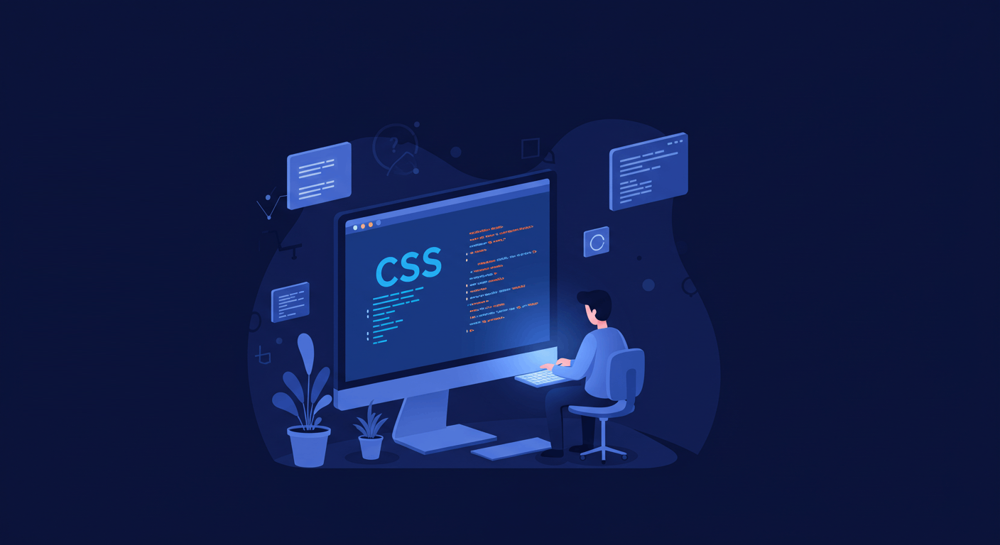- Start Learning CSS
- CSS Syntax and Selectors
- Applying CSS to HTML
- CSS Box Model
- CSS Layout Techniques
- Styling Text
-
Backgrounds and Borders in CSS
- Backgrounds and Borders
- Setting Background Colors and Images
- Background Image Sizing and Positioning
- Using Multiple Backgrounds
- Defining Border Properties
- Border Styles and Widths
- Rounded Borders with Border Radius
- Using Box Shadows for Depth
- Combining Backgrounds and Borders for Design
- Responsive Backgrounds and Borders
- CSS Transitions and Animations
-
Responsive Design with Media Queries
- Responsive Design
- Viewport and Media Queries
- Using Fluid Layouts with Percentages
- Flexbox for Responsive Layouts
- Grid for Advanced Responsive Design
- Responsive Typography Techniques
- Images and Media in Responsive Design
- Implementing Mobile-First Design
- Using Breakpoints Effectively
- Responsive Navigation Patterns
- CSS Frameworks
Welcome to this CSS tutorial, where you can gain a comprehensive understanding of Cascading Style Sheets (CSS) and elevate your web development skills. CSS is the backbone of web design, allowing developers to create visually appealing and responsive websites. In this article, we will cover the fundamentals of CSS programming, guide you through writing your first CSS code, and summarize the key points to solidify your understanding.
Introduction to CSS Programming
CSS, which stands for Cascading Style Sheets, is a style sheet language used to describe the presentation of a document written in HTML or XML. It provides a powerful way to control layout, fonts, colors, and overall aesthetics of web pages. CSS enables developers to separate content from design, thus improving maintainability and scalability of web applications.
The Evolution of CSS
Since its inception in 1996, CSS has undergone several revisions, each bringing new features and enhancements. The introduction of CSS2 in 1998 expanded the capabilities of CSS to include positioning, media types, and more. The latest version, CSS3, brought a host of new features, including new selectors, box model properties, transitions, animations, and flexbox for responsive layouts. Understanding these advancements is crucial for any intermediate or professional developer looking to leverage CSS effectively.
Core Concepts of CSS
Selectors: CSS selectors are patterns used to select elements you want to style. They can be simple (like element selectors) or complex (like attribute selectors and pseudo-classes). For example, to select all <h1> elements, you would use:
h1 {
color: blue;
}Properties and Values: Each CSS rule consists of properties and their corresponding values. For instance, the color property defines the text color, while the background-color property defines the element's background color.
Box Model: Understanding the box model is essential in CSS. Every element on a web page is considered a box and consists of margins, borders, padding, and the actual content. The box model affects layout and spacing, making it a fundamental concept to grasp.
Specificity: CSS specificity determines which styles are applied when multiple rules match an element. It follows a hierarchy, with inline styles taking precedence over embedded and external styles.
Writing Your First CSS Code
Now that we've covered the basics, let’s dive into writing your first CSS code. Setting up a simple HTML document and applying CSS styles to it can solidify your understanding.
Setting Up Your HTML
Create a basic HTML file named index.html with the following content:
<!DOCTYPE html>
<html lang="en">
<head>
<meta charset="UTF-8">
<meta name="viewport" content="width=device-width, initial-scale=1.0">
<title>My First CSS Page</title>
<link rel="stylesheet" href="styles.css">
</head>
<body>
<h1>Welcome to My First CSS Page</h1>
<p>This is a paragraph styled using CSS.</p>
</body>
</html>Creating Your CSS File
Next, create a CSS file named styles.css in the same directory as your HTML file. Begin with some basic styles:
body {
font-family: Arial, sans-serif;
line-height: 1.6;
background-color: #f4f4f4;
margin: 0;
padding: 20px;
}
h1 {
color: #333;
text-align: center;
}
p {
color: #555;
font-size: 18px;
}Analyzing Your Code
- Body Styles: The
bodyselector applies styles to the entire page, such as margin, padding, and background color. - Header Styles: The
h1selector customizes the main heading, centering it and setting its color. - Paragraph Styles: The
pselector adjusts the color and font size of paragraph text, improving readability.
Testing Your Code
To see your styles in action, open the index.html file in a web browser. You should see a neatly styled web page with your applied CSS. This hands-on experience is vital for reinforcing your knowledge.
Advanced CSS Techniques
Once you are comfortable with the basics, you can explore advanced CSS techniques such as:
Flexbox: A layout model that provides a more efficient way to layout, align, and distribute space among items in a container.
Example:
.container {
display: flex;
justify-content: space-between;
}CSS Grid: A powerful layout system that allows for two-dimensional layouts using rows and columns.
Example:
.grid-container {
display: grid;
grid-template-columns: repeat(3, 1fr);
}Media Queries: A key component for responsive design, allowing your styles to adapt based on the device's screen size.
Example:
@media (max-width: 600px) {
body {
background-color: #eaeaea;
}
}Understanding and mastering these advanced techniques can significantly enhance your ability to create dynamic and responsive websites.
Summary
In this CSS tutorial, we explored the fundamentals of CSS programming, guiding you through the setup of your first CSS code. We've covered essential concepts such as selectors, properties, the box model, and specificity. Additionally, we looked at how to implement basic styles and introduced advanced techniques like Flexbox, CSS Grid, and media queries.
CSS is an ever-evolving language, and continuous learning is essential for staying up-to-date with the latest standards and best practices. For further reading and resources, consider checking out the official W3C CSS documentation, which provides in-depth information and updates on CSS specifications.
With a solid foundation in CSS, you're well on your way to creating visually stunning and responsive web applications.
Last Update: 18 Jan, 2025

